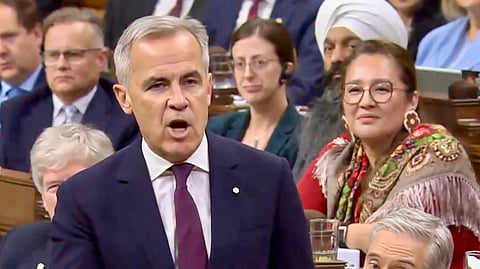

Fresh off a meeting with U.S. President Donald Trump on October 8, Prime Minister Mark Carney bragged in the House of Commons about being "a tough negotiator" having made zero progress on US tariffs.
"And we are still negotiating, because, as the president said yesterday, the prime minister of Canada is a tough negotiator," Carney said in the house to Liberal applause.
During the White House meeting, Trump lauded Carney as a “world-class leader,” “a good man,” and “a tough negotiator,” while telling him “we have great love for each other” even amid “natural conflict.”
Trump also said in front of Carney, who has a transgender child, "We have no men in women's sports. We're not going to take your child away and change the sex of your child. We're not going to do things like that."
At one point during the meeting, when reporters pressed why a tariff deal hadn’t been reached yet, Trump quipped, “Because I want to be a great man, too,” drawing laughter in the room.
Trump also revived a long-standing joke about the “merger” of Canada and the U.S., referring to Canada as the “51st state,” though Carney declined to play along.
Conservative MP Andrew Scheer hammered Carney in a statement, saying, "Now we know why Trump wanted Carney as PM. (Trump) knew he’d get everything he wanted. A trillion-dollar gift of Canadian investment flowing to U.S. mines, factories, sawmills. Canadians pay, Americans profit, and Carney refuses to even answer for himself."
The United States maintains a broad tariff regime against Canadian goods. A general 35 percent tariff applies to most non-energy imports from Canada, increased from 25 percent on August 1, 2025.
Canadian energy products and potash face a 10 percent tariff. In addition, steel and aluminum imports from Canada remain subject to 50 percent duties under Section 232 measures, which also cover derivative products.
The U.S. has also applied a 25 percent tariff on imported vehicles and auto parts not certified as USMCA-compliant, while semi-finished copper and derivative products face a 50 percent tariff based on copper content.
"Without even signing a deal, Carney has sold out Canadians - during his Washington trip he promised $1 trillion in investment that will go to US workers instead of Canadians," said Member of Parliament for Medicine Hat-Cardston-Warner Glen Motz.
"Every concession Mark Carney makes to Donald Trump comes at the expense of Canadian workers, and empty promises won’t solve the problem."
Although goods that fully meet USMCA origin requirements may qualify for partial or full exemptions, implementation remains inconsistent and under review. Enforcement measures have tightened against transshipment, and further tariffs—potentially on semiconductors, pharmaceuticals, and heavy trucks—are being discussed but have not been enacted. These figures are based on verified trade updates from the Trade Commissioner Service of Canada.
Canada is facing a growing federal deficit alongside signs of economic stagnation. In 2023-24, the deficit widened to about C$61.9 billion (≈ 2.1 % of GDP), up from roughly C$35 billion in 2022-23. For 2024-25, the deficit is projected to remain large, at around C$50-68 billion (≈ 1.6-2.2 % of GDP), reflecting higher spending and weaker growth. Meanwhile, GDP growth has been tepid: the Parliamentary Budget Office forecasts about 1.7 % growth for 2025.
The Liberals are trying to remedy Canada's economic stagnation. Carney has introduced several measures to strengthen Canada’s economy amid slow growth and rising deficits.
His government launched a $5 billion Strategic Response Fund to help businesses affected by U.S. tariffs adapt and expand, while promoting major infrastructure investments in transport and trade corridors to boost productivity.
Carney is also working to reduce inter-provincial trade barriers, speed up project approvals, and shift fiscal policy toward “spend less, invest more” by curbing operating costs while increasing capital spending on housing, energy, and defense.
Additionally, new worker-training and reskilling programs aim to support up to 50,000 Canadians transitioning into higher-demand sectors.